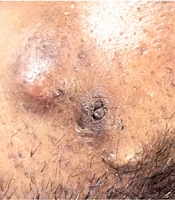Dear Editor,
Cystic skin lesions, such as cystic acne, hidradenitis suppurativa, and infected epidermoid cysts, are drained early to expedite healing and prevent the formation of ugly scars on healing. As per conventional practice, cysts are drained by manual vertical pressure with hands after making a nick/hole with a surgical blade or needle. Unfortunately, manual vertical pressure with hands is not possible at all sites, and sometimes the evacuated pus causes soiling of the surrounding skin and spurts on the attending physician, thereby creating a mess (1, 2). There is also the contamination of the pus material in cases where it has to be sent for microbiological examination. Few innovative methods have been used to drain the cysts, and intralesional injection is given to resolve the cyst; however, it is a slightly cumbersome and incomplete evacuation of the content and incidence of recurrence (3-5). Incision and drainage, deroofing, negative suction, cryopunch, and biopsy punch for draining hidradenitis cyst/sinus have been proposed (6,7).
It is recommended to use a disposable syringe barrel for pus drainage and collection in such cases to overcome the above-mentioned problem. In this procedure, the site is aseptically prepared (Figure 1A). A syringe of appropriate size is taken as per the diameter of the cyst. The cyst is punctured with a needle connected to the syringe, and the needle is recapped (Figure 1B). The syringe’s piston is removed from the barrel, and the open barrel end is kept over the cyst in such a way that it covers the whole cyst. Gentle vertical pressure is applied; accordingly, the maximum possible exudative material is expressed out and collected in the syringe’s barrel (Figure 1C). At the time of drainage, the barrel should be on a dependent part; accordingly, the exudative material can be easily collected by gravitational force and vacuum effect in the syringe barrel (Figure 1D). This procedure can be performed in a sitting or a lateral lying down position. This barrel helps in the evacuation and collection of cyst content.
To resolve the cyst, the epithelial lining of the cyst wall should be enucleated, cauterized with trichloroacetic acid, electrocoagulation, radio-frequency or cryotherapy or sclerosed with hypertonic saline after draining the cysts to avoid its recurrence. Following cauterization, the patient is called after 3 to 5 days to evacuate the damaged cyst wall, and the cyst subsides after 1 week and heals within 4 weeks (Figure 2A - F). Therefore, a disposable syringe barrel is a simple, easily available, and cost-effective sterile drainage tool to drain cysts in a clean and effective manner and collect minimally contaminated exudative specimens.
Key Points/Message:
- Cyst drainage is critical for the rapid clearance of cysts.
- A variety of novel techniques have been proposed, including a three-way cannula, a hypodermic needle vent for drainage, and intralesional triamcinolone acetonide. However, it is a slightly tedious and time-consuming task with insufficient drainage of the content.
- Suction-assisted drainage has been documented, which necessitates additional pressure and hemorrhage.
- The traditional way of incision and draining of the cyst and manual pressure results in soiled clothes, floor, and clinic, which is not a preferable approach.
- To avoid sprinkling of the extracted substance, it is collected in the device with less bleeding and better drainage since pressure is applied from all sides, compared to the conventional method.


